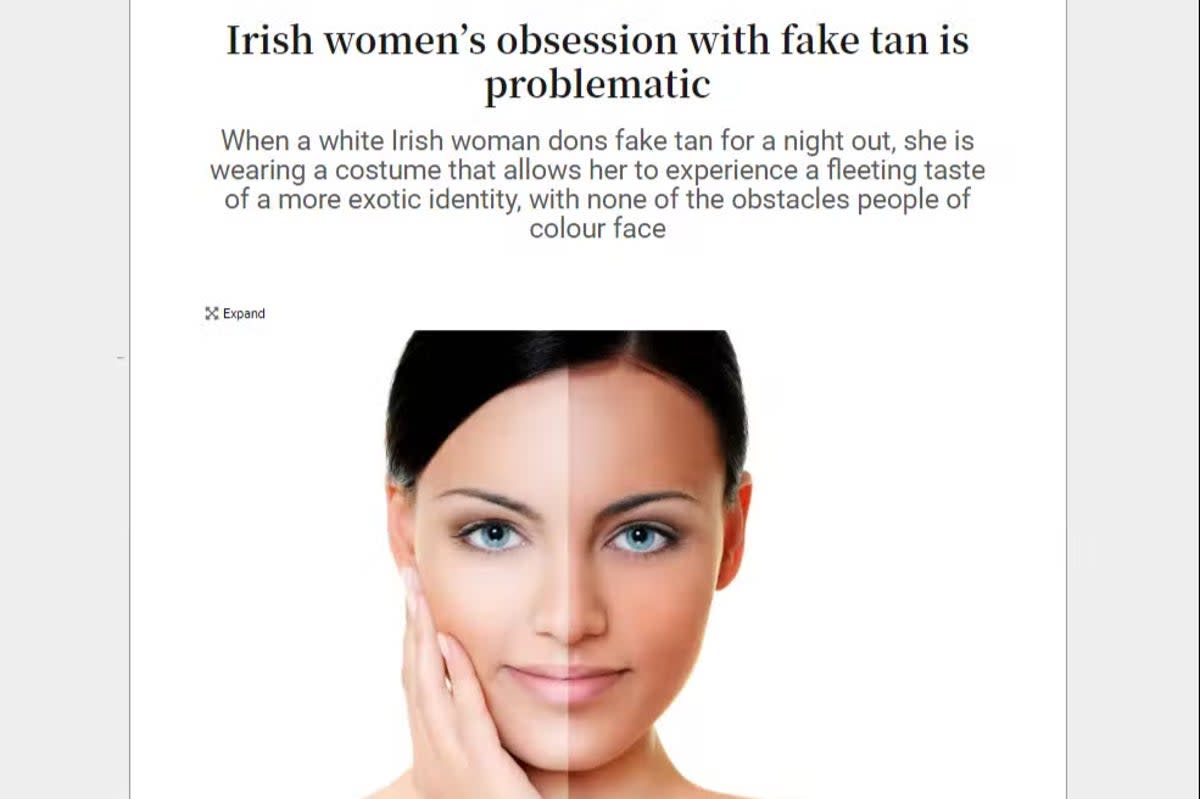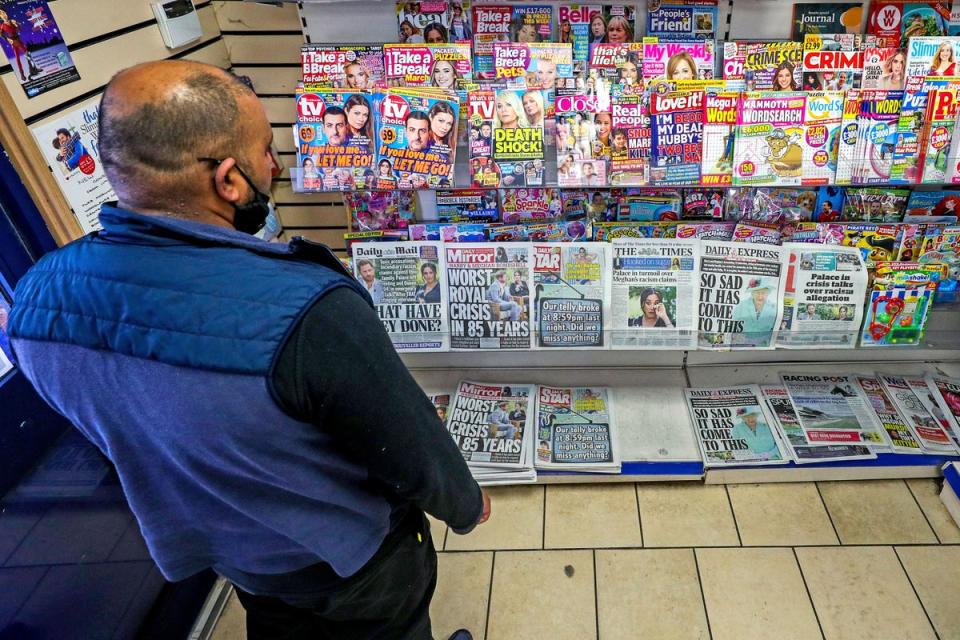How a student tricked the Irish Times into running a fake AI-written opinion piece

Ireland’s national newspaper, the Irish Times, was on Sunday forced to apologise after mistakenly publishing a contentious opinion piece that was found to be written by artificial intelligence (AI).
The article, entitled “Irish women’s obsession with fake tan is problematic”, was published on Thursday, May 11.
The author criticised Irish women for wearing fake tan, saying that in doing so, there was a “risk of devaluing the authentic experiences of individuals with naturally high melanin content, reducing their identity to a mere fashion accessory”.
The author was bylined as a Latin American migrant woman named Adriana Acosta-Cortez, who was said to live in north Dublin. The accompanying byline photo was of a woman with blue hair.
“To my Irish sisters, I would ask you to consider the implications of your choices and to question the societal norms that guide them. I am not trying to shame or judge those who love to tan, but I do want to provoke thought and conversation around the broader issues that it represents,” the article said.
“In the spirit of solidarity and sisterhood, I encourage you to explore alternative methods of self-expression that do not contribute to the appropriation or fetishisation of melanin. Let us work together to challenge, and to dismantle.”
However, the piece was fake. On Sunday, the Irish Times’ editor Ruadhán Mac Cormaic published a statement, in which he admitted that the paper had “got it badly wrong” by publishing the piece.
He explained that over several days, the author of the column had communicated with the editorial desk; supplied links to relevant research; offered personal anecdotes; and even taken on board suggestions for edit. Such practices mirrored those of a regular person who wanted to be published in a national broadsheet.
But less than 24 hours after the piece was published online, the Irish Times was made aware that the column might not have been genuine.
“It now appears that the article and the accompanying byline photo may have been produced, at least in part, using generative AI technology,” Mr Mac Cormaic said.
“It was a hoax; the person we were corresponding with was not who they claimed to be. We had fallen victim to a deliberate and coordinated deception.”
It is believed that after the column went viral on Reddit in Ireland, other journalists began to take an interest. Two journalists from Irish online business magazine The Currency ran the byline photo through several AI photo analysers. The probability of the photo being fake was found to be 93.8 per cent.
Journalists from several publications then contacted the Irish Times for comment, after which the paper decided to remove the column and conduct an investigation.
Trickster used ChatGPT and DALLE-2
Might be wrong about this but something seems really off about the author photo that ran with this Irish Times fake tan article. @keyes and I ran it through a few AI checkers and results are.... https://t.co/3KYQKleYZ8 pic.twitter.com/ZsNqtuLIFN
— Rosanna Cooney (@RosannaCooney) May 12, 2023
The Standard has spoken to the person behind the fake AI-generated article and viewed correspondence between the Irish Times and them.
The person, who is a non-binary Irish undergradraduate student, has chosen not to be identified over fears they might be expelled from their university in Ireland.
“It’s a conversation I’d had with friends before while discussing cultural appropriation in fashion, a girl told me that race was based on skin tone so I brought up the fake tan that she used while playing devils advocate,” they told The Standard.
The person asked OpenAI’s popular large language model (LLM) chatbot ChatGPT to write a 1,000-word opinion piece “on how fake tan is appropriating and fetishising the high melanin content of more pigmented races, from the point of view of a non-binary latinx woman of colour living in Dublin, Ireland”.
They also specified that the AI should “emphasise the fake tanning culture in ireland and address the piece to Irish women”.
When the person was sent feedback by the Irish Times, they then pasted the editor’s remarks and ChatGPT’s first attempt at the article and asked the AI to revise it. They also asked the chatbot to make the tone of the piece “more conversational”.
For the photo, they asked image generator Dalle-E 2 to produce an image of a journalist using the prompts “female, overweight, blue hair, business casual clothing, smug expression”.
“I’d say the final piece was 80-90 per cent AI-produced,” the person explained. “I was shocked that the Irish Times was so eager to publish it pending some minor revisions, and that they didn’t contact me by phone to validate my identity.”
They added that they made the trick submission partly to amuse their friends. But, more importantly, they wanted to make a statement about identity politics and how these can be used in the media and online to distract the public from more important issues, such as government policies and the economy.
”There’s no clear end in sight or obvious finishing line. It’s an easy distractor for the masses to infight about gender, race or sexuality instead of noticing the failings of a greedy government,” the individual said.
“Even the response from the Irish Times, and the focus in Irish media covering the story has just been on the AI aspect, and maybe on the poor job the paper did of background checking. No one is talking about the content of the article and how it was leveraged to get people fighting on Twitter.”
The individual says they realised the game was up when they pitched a second story on Friday afternoon and the Irish Times asked for their phone number. They provided them with the phone number for a clown service in Dublin and continued to email the newspaper, but did not speak with the publication.
They also requested that their fee for writing the piece be donated to charity.
The Standard has contacted the Irish Times to verify the individual’s story.
Should AI be used in journalism?

Let’s face it — the media industry is not in a good place right now. But amid the sea of seemingly neverending restructures and redundancy announcements from some of the world’s biggest and most respected publications, editors are trying to work out how, or even if, AI should be used in journalism.
“We are all grappling with the potentially enormous implications of artificial intelligence for journalism,” Charlotte Dewar, chief executive of the the UK’s Independent Press Standards organisation (Ipso) told The Standard.
“At Ipso, we are developing our thinking on this issue and how it relates to our regulation, but we know that editorial responsibility will remain a core principle: editors are accountable for their reporting and editorial standards, regardless of the technology they are using. They need to be vigilant to ensure their content adheres to the Editors’ Code of Practice.”
In April, The Guardian decided to issue a rare statement about AI, after being contacted by several students and researchers.
They had used ChatGPT to help them with literature reviews. They had kept being told by the AI about interesting-sounding Guardian articles that would be excellent additions to their work, but couldn’t find them.
The Guardian realised that ChatGPT was suggesting fake Guardian headlines that sounded just like articles written by its staff.
Chris Moran, the Guardian’s head of editorial innovation, said that the paper had created a team that was learning about the technology and consulting with academics, other organisations and its staff about how generative AI performs when applied to journalistic use. He said the paper wasn’t yet sure about the technology.
“In doing this, we have found that, along with asking how we can use generative AI, we are reflecting more and more on what journalism is for, and what makes it valuable,” he said.
“We are excited by the potential, but our first task must be to understand it, evaluate it and decode its potential impact on the wider world.”

 Yahoo News
Yahoo News 
